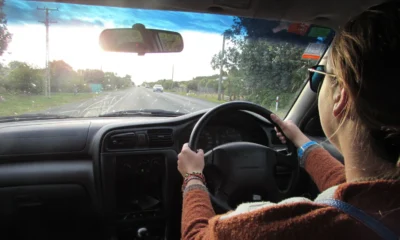Travel
Why I Travel Journal And You Should Too

I like to journal. In fact, I’ve been writing about my life with regularity since I was nine years old. And I make no exception when I travel. In fact, I journal even more while I’m on a trip than I do at home. Even though it can take up a lot of my time, I feel compelled to journal about my experiences on the road. Here are five reasons why:
See Also :A Few Days In Asheville, NC
You Are Writing for Your Future Self.
As with any journal I’ve kept, I love being able to read about something I did and see it through the eyes of my past self. It not only brings me joy to relive a tip but re-reading old journals also helps me recall details I never would remember otherwise. It’s been three years since my trip to Costa Rica and I don’t think I could have remembered the names of all of the village tiendas if I hadn’t been journalling about it.
While I tend to generally write about the details of the day, I also jot down other things that I’d like to remember. Things like pronunciation guides, songs I heard in specific places, the history of a site I visited, a little map of the area I walked in, or some interesting facts I read in a book. I’m always learning a lot of information about the new places I visit that I know would normally just disappear from my memory. Once it’s on the page, the information won’t get lost.

Emmett caught me tired and about to start journalling at a helpx stay in New Zealand
2. Writing is Cathartic.
When I’m having a crappy time somewhere, I will feel a lot better about it if I can write down every little thing that’s bothering me. A drunk guy peed on the floor of the dorm room? The airline lost my luggage? I’m covered in ultra-itchy bed bug bites? You can bet I wrote some angry words about all of those things in my journals. It was much easier to let go of my frustrations once they were all written on the page.
3. It’s a Scrapbook.

My journaling supplies: the journal itself, a glue stick, scissors, souvenirs to paste, a few pens.
I don’t know about you, but I like to hold onto every little ticket stub, brochure, map, paper with traveler contact info, business card, or flier that finds it’s way into my hands. I always seem to end up with a pile of travel memorabilia in the bottom of my backpack – even after only a few days. Instead of just periodically throwing all of that nostalgia in the bin or keeping it in a messy pile somewhere, I long ago decided that the best thing to do with it is put it all in one accessible place. So: I glue them into that day’s journal entry. Now my journals are like little diary-scrapbook hybrids. I like that pasting papers and tickets into my journal visually breaks up the pages upon pages of my sloppy handwriting. Not only that, but the scraps I paste in can further jog my memory back to a specific time or place.
4. Waste Waiting Time.
Waiting is an inevitable part of traveling. Waiting for a flight/bus/train
to leave? You can catch up on journaling. Not only that but I’ll write once I get on that train, plane, or bus I’d waited for. Sometimes I’ve even found myself sitting & waiting for a hostel to open or a dorm room to be ready. That’s journal time. I can always find the time to to write at least a little bit.

Stepping away from my open journal on the patio of our hostel in Nadi, Fiji while we waited for reception to officially open.
5. Your Journal Becomes a Reference.
The more I’ve traveled, the more I’ve had relatives and friends ask me for information on places I’ve visited. All I have to do is flip through my journal from that trip to find names, locations, or directions. Oftentimes I’ll also write down advice given to me by other travelers about places I haven’t even been to yet. For example, when I was planning the New Zealand trip I remembered that I’d met a guy in Prague who’d done aWorking Holiday. I then looked through my journals from Europe and found his recommendations.
All in all, I highly recommend journaling while you travel. Even if you’ve never journaled before, traveling is honestly the best time to do it. A travel journal is a unique and personal souvenir that will preserve your trip forever.

An entry in my first journal of the New Zealand trip featuring a map of the top half of the South Island with a drawn line noting our hitch-hiking route for that day.
Destinations
Madeira Travel Guide: Top Attractions, Hidden Gems & Local Tips
Destinations
Amalfi Coast Travel Guide: A Journey for Every Type of Traveler
Travel
How to Choose the Best Fat Tire Electric Bike for Different Terrains

How to Choose the Best Fat Tire Electric Bike for Different Terrains
Choosing the best fat tire electric bike for your terrain isn’t just about looks—it’s about performance and comfort. The right e-bike depends on where you ride: smooth pavement, rocky trails, sandy beaches, or snowy roads. Each surface demands specific tires, suspension, and motor power.
This guide will walk you through how to pick the perfect fat tire e-bike for every type of terrain.
What Makes Fat Tire Electric Bikes Unique?
Fat tire electric bikes stand out because of their oversized tires—usually 4” to 5” wide—that offer better traction and stability. Whether it’s a moped-style electric bike for city cruising or a rugged off-road model, these bikes handle diverse terrains with ease.
Key Advantages:
- Excellent grip on loose or slippery surfaces
- Smoother ride on uneven terrain
- Better balance for new riders
- Support for heavier loads or cargo setups
Most fat tire e-bikes feature 500W to 1000W motors and ≥80 Nm torque, making them ideal for both hills and flat roads.
1. Best Fat Tire Electric Bike for City Streets
If you’re riding mostly on asphalt, paved trails, or urban bike lanes, comfort and efficiency matter most.
What to Look For:
- Tire Type: Semi-slick or hybrid tread (4.0”) for low rolling resistance.
- Motor Power: 500–750W hub motor for smooth acceleration.
- Battery Range: At least 48V 15Ah (40–50 miles per charge).
- Suspension: Front fork only—light and efficient for city use.
- Frame Style: Step-thru or moped-style electric bike for easy mounting.
Example setup:
A 750W fat tire commuter e-bike with 20″x4″ semi-slick tires offers great traction without draining power on smooth roads.
Pro Tip: Inflate your tires to 20–25 PSI for better efficiency and speed on pavement.
2. Best Fat Tire Electric Bike for Mountain Trails
Mountain terrain demands more power, stronger frames, and better suspension.
What to Look For:
- Motor: 750W–1000W mid-drive motor with ≥80 Nm torque for hill climbing.
- Suspension: Full suspension (front + rear) to absorb shocks.
- Tires: Deep tread 4.8” tires for traction on gravel and mud.
- Brakes: Hydraulic disc brakes (180mm rotors) for steep descents.
- Battery: 48V 20Ah or dual-battery setup for long trail rides.
- Ideal PSI: 12–18 PSI for rocky trails.
Pro Tip: A mid-drive motor keeps your center of gravity low and improves handling on tight, winding paths.
3. Best Fat Tire Electric Bike for Snowy Conditions
Snow requires traction and stability—this is where fat tire e-bikes truly shine.
What to Look For:
- Motor: 750–1000W rear hub motor (torque ≥85 Nm).
- Tires: 4.8” studded or knobby tires for maximum grip.
- Frame Material: Aluminum alloy to prevent rust.
- Battery: High-capacity 48V 17–20Ah (cold weather drains battery faster).
- Fenders: Full coverage to block slush and debris.
Pro Tip: Keep your battery warm indoors before riding—it maintains up to 15% more charge efficiency in winter.
4. Best Fat Tire Electric Bike for Beach or Sand Riding
Soft sand is tricky. You’ll need wide tires, a strong motor, and corrosion resistance.
What to Look For:
- Tires: Ultra-wide 4.5–5.0” tires with low PSI (8–12 PSI).
- Motor: 750W or 1000W rear hub motor for consistent power.
- Battery: 48V 15Ah minimum—sand adds resistance.
- Frame Coating: Anti-rust treatment or aluminum alloy frame.
- Drivetrain: Sealed components to protect from sand and salt.
Pro Tip: After beach rides, rinse your e-bike with fresh water and dry it thoroughly to avoid corrosion.
Comparison Table: Fat Tire E-Bike Terrain Guide
| Terrain Type | Ideal Tire Width | Motor Power | Suspension | Battery | Recommended PSI |
| City Streets | 4.0″ semi-slick | 500–750W | Front | 48V 15Ah | 20–25 PSI |
| Mountain Trails | 4.8″ knobby | 750–1000W | Full | 48V 20Ah+ | 12–18 PSI |
| Snow | 4.8″ studded | 750–1000W | Front | 48V 17Ah+ | 10–15 PSI |
| Beach/Sand | 4.5–5.0″ | 750–1000W | Front | 48V 15Ah+ | 8–12 PSI |
Extra Features Worth Considering
- Pedal Assist Levels: Choose models with at least 5 PAS modes for flexibility.
- Display: An LCD with real-time speed, range, and PAS data helps monitor performance.
- Lighting: Integrated LED lights improve safety for night rides.
- Accessories: Racks, baskets, or child seats can make your ride more functional.
Tips for Beginners vs. Advanced Riders
For Beginners:
- Start with a step-thru frame for easy handling.
- Use pedal assist mode to extend battery life.
- Keep tires at higher PSI for smoother roads.
For Advanced Riders:
- Go for dual batteries if you ride long distances.
- Experiment with lower PSI on dirt or snow for more grip.
- Upgrade to hydraulic brakes for precision control.
Conclusion
The best fat tire electric bike depends on where you ride most. City commuters should look for semi-slick tires and moderate power, while mountain and beach riders need wider tires, stronger motors, and solid suspension. By matching your bike’s setup to your terrain, you’ll enjoy smoother rides, longer range, and better control.

 Blog10 months ago
Blog10 months agoHow to Deal with Scabies While Traveling

 Travel10 months ago
Travel10 months agoRichmond, Virginia Street Art Guide

 Travel10 months ago
Travel10 months agoPerhentian Islands: How to Get There, What to Expect, & More

 Travel10 months ago
Travel10 months agoHow to Live in Your Car in New Zealand

 Travel10 months ago
Travel10 months agoSouvenir in Nepal: A Guide to Unique Handicrafts and Cultural Treasures

 Travel10 months ago
Travel10 months agoVegan Guide to Dining Out in Richmond, Virginia

 Food10 months ago
Food10 months agoVegetarian Food Nepal: A Journey into Flavorful Plant-Based Cuisine

 Travel7 months ago
Travel7 months agoA Local’s Guide to Sanibel Island, Florida

















